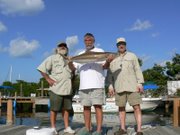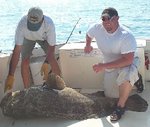Before we start, tarpon fishing isn’t my favorite. It’s fine when they bite, but tarpon can be very closed mouth. They also tend to bite at night. I tend to prefer drinking at night. So I’ve reached a compromise with these big silver guys. I’ll fish for them between dawn and at dusk. While tarpon will take a plug, pinfish, crab or dead bait, I don’t go bridge fishing if I don’t have live mullet. That said, here we go with the basics.
The rig for Tarpon is fairly simple, 5 to 10 foot of double line, with 5 to 8 foot of 50 to 80 pound clear mono leader with roughly a 6/0 J or 9/0 circle hook. The size of the hook really depends on size of the bait and the size of the fish you are targeting. For first timers, the J hooks are more productive and don’t really injure very many fish. Why, because first time tarpon fishermen normally freak out and do every thing wrong! The J hook is more forgiving. Depending on the current and the bait, I may add a swivel in the leader about 3 to 4 feet in front of the bait. I normally only use spinning tackle, conventional and bait casters tend to back lash too often.
Circle hooks are the way to go with Tarpon if you know what you are doing. Sizing the circle is very important. The gap has to be wide enough to catch in the jaw of the fish. Most of these fish are pretty big, 60 pound and way over. With the new style circles, you get a wider gap with a lighter weight hook. Look for a well-made circle with at least a half-inch gap. Snelling the circle hooks using a Uni-knot is very easy, but tying straight works. Circles hooks require a drop back on a tarpon pick-up. When dead sticking, my method goes back to old school. On a spinning outfit, use a piece of copper rigging wire at the reel seat to loop a half turn around the line and leave the bail open. When the wire trips, let the fish take enough line to turn and close the bail. There is no hook-set, just let the fish tighten the line in his own good time. When the hook sets on a Tarpon, most people notice. Then it’s game on! When drifting or free lining the mullet, the angler has to be like the release wire. Let the fish eat, turn and then close the bail, NO HOOK SET!
Bridge fishing, your captain will have an anchor ball so he can cut lose and chase the fish. The first minute or so is critical. Tarpon have a tendency to take anglers around the bridge structure. With the hook-up, your captain has to hit the right hole in the bridge to follow the fish. Don’t put any pressure on the fish if it looks like she has taken you around a pile. Let the captain work it out and then start fighting the fish. With a good current at the bridge, tarpon are more predictable fighters and normally go with the current. This makes everybody’s life easier. When the Tarpon jumps, just keep a bend in the rod, don’t bow to or over pressure the fish on a leap and the hook will normally stay put.
With J hooks, only a short drop back (normally just point the rod at the fish) and one or two firm hook-sets. Make sure these hooks are sharp and filing down the barb a little isn’t a bad idea. Tarpon have a very bony mouth and can be difficult to hook. Live blue crabs, pinfish, live or dead ballyhoo, will all produce Tarpon so you should be well armed bait wise. Chunking with dead sardines or herring can be very effective if you have Tarpon rolling in the area and not moving on your live baits. This is also extremely effective on resident, off-season, Tarpon. Plugs like Bomber long A’s and the like work quite well, cast to the fish, let it set for a few seconds and start a slow retrieve. On the strike again, one or two firm hook sets and play your fish.
Tarpon make great shark bait so don’t get too surprised if a hammerhead or bull shark eats your fish. It’s just nature doing it’s thing. The sharks will also take your bait so don’t be surprised if you end up with a 300 pound shark dragging you all over the place.
Daytime Tarpon fishing (more than two hours after sunrise) is more like hunting than fishing. Once you find fish that aren’t moving down the road, they will fall for all the baits previously mentioned or nothing at all. I’ve been surrounded by hundreds of Tarpon that just would not feed. When they turn on, they really turn on. But if they don’t want to bite, grab a cold beer and your camera. It is fishing after all.
April, May and June are my favorite months for tarpon. As I said, morning and evening trips are all that I normally, run in these months. Full day backcountry trips are also productive for Tarpon, plus you have a large variety of other critters to play with. It is all good, just be aware of what you are getting into. It may take a couple of trips to put you on the fish you really want. I wanted to add a photo, but since hurricane Wilma wiped out my other computer along with just about everything else I own, I can’t. I’m looking at a nice 100-pound fish on my bulletin board. Maybe I’ll go scan it and add the photo later.
Tight Lines,
Capt. Dallas


